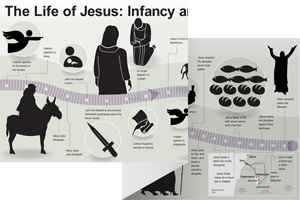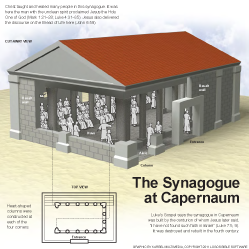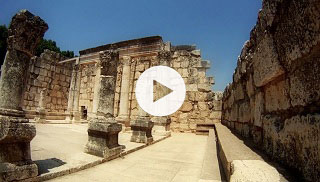4:1–13 Like Matthew, Luke records Jesus’ wilderness temptation following His baptism. |
4:1 in the wilderness In the ot, the wilderness is the place where God meets with His appointed messengers, such as Moses at the burning bush (Exod 3) and on Mount Sinai (Exod 19). The wilderness also is where God tests the Israelites on their journey to the promised land (Deut 8:1–18).
4:2 forty days Recalls Moses’ 40 days on Mount Sinai, the Israelites’ 40 years of wandering, and Elijah’s 40 days in the wilderness of Horeb.
the devil The Greek word used here, diabolos, is used in the Septuagint (the ancient Greek translation of the ot) to render the Hebrew word satan, which means “the accuser” or “the adversary.” This term appears infrequently in the ot. It is used for the accuser of Joshua the high priest (Zech 3:1–2), for the inciter of David to conduct a census (1 Chr 21:1), and for the spiritual being in Job 1–2 (see Job 1:6 and note). Here diabolos refers to an evil, spiritual figure—synonymous with satan in Mark’s synopsis of Jesus’ temptation (see note on Mark 1:13).
he ate nothing See note on Matt 4:2.
4:3 If you are the Son of God This identity is affirmed explicitly in Luke 3:38.
4:4 It is written Jesus refutes each of the devil’s temptations by quoting Scripture. Here he quotes Deut 8:3.
4:5 in a moment of time The precise meaning here is uncertain. Some kind of visionary experience might be involved, but the text does not indicate this.
4:6 I will give The devil uses language reminiscent of the ancient Israelite belief that the nations were under the control of evil foreign powers (see Deut 32:8 and note).
4:7 will worship before me See Matt 4:9 and note.
4:8 Worship the Lord your God Jesus’ reply comes from Deut 6:13.
4:9 highest point Probably refers to a high point on the front of the temple, rather than a point overlooking the Kidron Valley. If the devil is encouraging Jesus to make a public display, the side of the temple facing the city is a more likely setting.
4:10 He will command his angels concerning you In vv. 10–11, the devil quotes Psa 91:11–12, perhaps mocking Jesus’ use of Scripture. Both lines are taken out of context; the psalm clearly is not about angels protecting people who jump off buildings. Rather, the sense is that Yahweh’s protection is so near and careful that His angels could even stop people from hurting their feet while walking.
4:12 to the test Jesus quotes Deut 6:16, which refers back to the Israelites testing Yahweh in Exod 17:2–7.
4:13 until a favorable time Unlike Luke, Matthew’s and Mark’s temptation accounts report angels ministering to Jesus at this point (Matt 4:11; Mark 1:13). Luke adds that the devil will return. This might refer to Luke 22:3.
4:14–15 These verses imply that Jesus left His hometown of Nazareth and moved to Capernaum for a time (Matt 4:13 states this explicitly). |
4:14 Galilee Jesus begins His mission in the most ethnically and culturally diverse portion of Israel. The rest of the Jewish people viewed Galilee as only moderately Jewish. Jesus begins where He is most needed—among the marginalized.
as only moderately Jewish. Jesus begins where He is most needed—among the marginalized.
4:15 synagogues See note on Matt 4:23.
4:16–30 In addition to John’s arrest (see Matt 4:12), Jesus’ rejection in his hometown might have influenced his move to Capernaum. The people in Nazareth knew Him as the son of Joseph and Mary, not as the Messiah. Although they initially received Jesus’ message favorably, the people of Nazareth eventually try to kill Jesus because He criticizes their unbelief. Compare Matt 13:53–58. |
4:16 Nazareth See note on Luke 1:26.
4:17 the scroll of the prophet Isaiah The following quotation of Isa 61:1–2 and 58:6 is a proclamation by Jesus that He is the anointed one of Yahweh (see note on Luke 1:27; compare 3:22; 4:1, 22). Within the context of Isaiah, this indicates that Jesus is claiming to be the Messiah (Isa 11; compare Isa 7:10–25; 9:1–7) and the Suffering Servant (Isa 42:1–9; 49:1–12; 50:4–11; and Isa 52:13–53:12).
4:18 The Spirit of the Lord is upon me Jesus reads from Isa 61:1–2.
 Jesus’ Fulfillment of Old Testament Prophecy Table
Jesus’ Fulfillment of Old Testament Prophecy Table
to send out in freedom Jesus alludes to Isa 58:6.
4:20 sat down Jesus assumes the usual position of a teacher; the reader stood while reading (Luke 4:16) but sat to offer the explanation.
were looking intently at Him They were waiting for Him to interpret the passage He had just read.
4:21 Today this scripture has been fulfilled Jesus explicitly declares that He is fulfilling the promise of consolation to Zion (Isa 61:1–2) in a new way (see Luke 2:25; 7:22). Through this declaration, He implies that He is Yahweh’s Messiah.
4:22 they were all speaking well of him The people of Nazareth initially receive Jesus’ messianic claims favorably.
Is this man not the son of Joseph Questions about Jesus’ identity are a recurring theme in Luke’s account of Jesus’ ministry in Galilee (see v. 34 and note; 5:21; 7:20; 8:25).
4:23 Physician, heal yourself The Greek text here could be understood as “heal your kin,” as the rest of this verse indicates. The people of Nazareth want to experience Jesus’ healing power.
4:24 no prophet is acceptable in his own hometown To illustrate this remark, Jesus proceeds to cite two stories in which ot prophets aided Gentiles (non-Jews) rather than Israelites (vv. 25–27).
4:26 only to Zarephath The story of Elijah and the widow of Zarephath appears in 1 Kgs 17:8–24.
Sidon Located northwest of Israel. Its residents were Gentiles (non-Jews) who worshiped Baal, the Canaanite storm-god.
4:27 Naaman the Syrian Commander of the army of Syria (Aram), an enemy of Israel. The account of Naaman’s healing appears in 2 Kgs 5:1–14.
4:28 filled with anger The people are angry because Jesus spoke of Gentiles (non-Jews) receiving God’s aid while Israel had to suffer.
4:31–44 Jesus returns to Capernaum, His new base of operations. Luke summarizes some of the teaching and miracles that occurred there. |
4:31 Capernaum A village on the northern shore of the Sea of Galilee.
A fishing town with both Jewish and Gentile (non-Jewish) inhabitants, Capernaum’s position on a trade route made it more cosmopolitan and diverse than other towns of similar size. Jesus performed many of His signs in Capernaum |
was teaching them on the Sabbath See v. 16.
4:32 because he spoke with authority Jesus did not refer to the rabbis when He taught; He did not need any authority beyond His own. He expounded on the words and ideals of the Hebrew Scriptures without consulting others.
4:33 in the synagogue It is surprising that a demon-possessed person was in a synagogue. Luke might be subtly critiquing the spiritual state of Capernaum at the inception of Jesus’ public ministry. Elsewhere, encounters with demons mark the inauguration of the kingdom of God (Matt 12:28; Luke 11:18–20).
spirit of an unclean demon See note on Mark 1:23.
4:34 the Holy One of God The demon is aware of Jesus’ identity and divine authority.
4:36 What word is this People continue to wonder about the identity of Jesus (see note on Luke 4:22).
4:38 Simon’s mother-in-law was afflicted Parallel accounts of this healing occur in the other Synoptic Gospels (Matt 8:14–17; Mark 1:29–34).
4:43 kingdom of God Refers to God’s sovereign rule and its effects. See note on Mark 1:15; note on Acts 1:3.

|
About Faithlife Study BibleFaithlife Study Bible (FSB) is your guide to the ancient world of the Old and New Testaments, with study notes and articles that draw from a wide range of academic research. FSB helps you learn how to think about interpretation methods and issues so that you can gain a deeper understanding of the text. |
| Copyright |
Copyright 2012 Logos Bible Software. |
| Support Info | fsb |
 Loading…
Loading…




 Capernaum
Capernaum